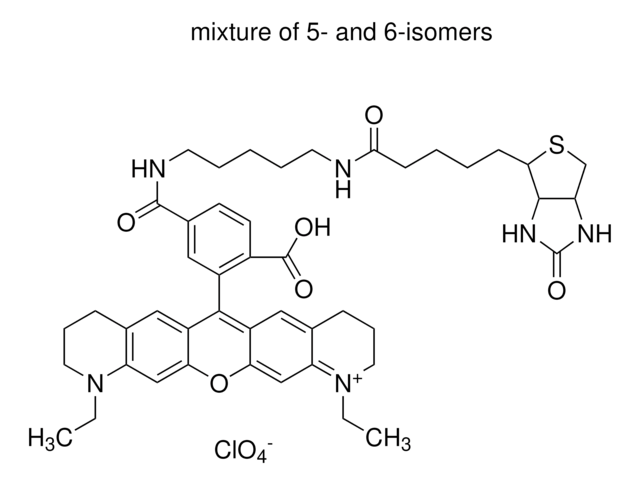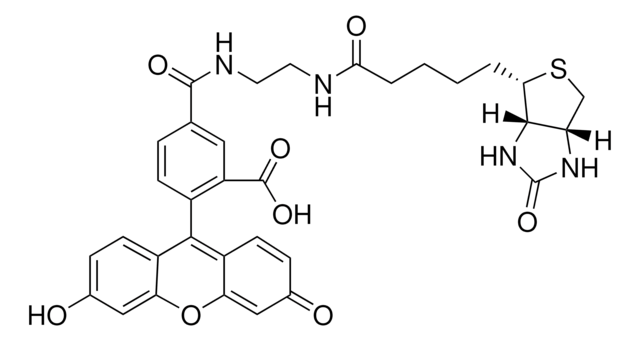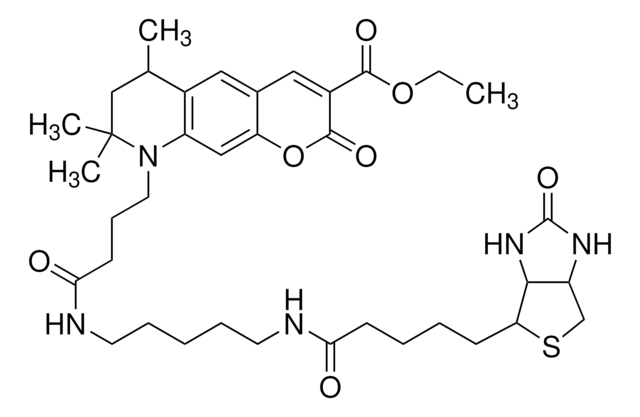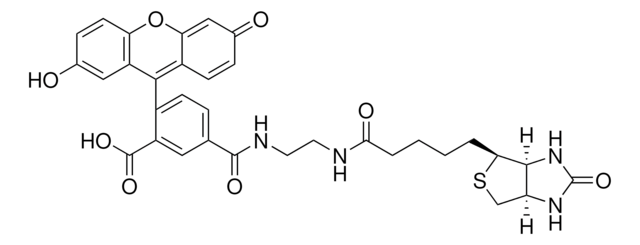06966
Atto 655-Biotin
BioReagent, suitable for fluorescence, ≥90% (HPCE)
Synonym(s):
Biotin-Atto 655
Sign Into View Organizational & Contract Pricing
All Photos(1)
About This Item
UNSPSC Code:
12352116
NACRES:
NA.32
Recommended Products
product line
BioReagent
Quality Level
Assay
≥90% (HPCE)
form
powder
manufacturer/tradename
ATTO-TEC GmbH
transmittance
254 nm
655 nm
solubility
DMF: soluble
DMSO: soluble
acetonitrile: soluble
fluorescence
λex 655 nm; λem 680 nm in 0.1 M phosphate pH 7.0
λ
in ethanol (with 0.1% trifluoroacetic acid: 655 nm ± 3 nm)
suitability
suitable for fluorescence
storage temp.
−20°C
Application
Atto 655 conjugated to biotin is useful for binding to proteins (i.e., avidin and streptavidin). The fluorescent properties include excellent thermal and photo-stability, high quantum yield, strong absorption (663 nm) and fluorescence (684 nm), and low triplet formation. It is a zwitterionic dye, carrying a net electrical charge of zero. Electron donors such as guanine and tryptophan can easily quench the fluorescence of this fluorophore. Biotin conjugated with ATTO 655 was applied to assess efficiency of BSA/avidin structures bound to a surface.
Legal Information
This product is for Research use only. In case of intended commercialization, please contact the IP-holder (ATTO-TEC GmbH, Germany) for licensing.
Not finding the right product?
Try our Product Selector Tool.
Storage Class Code
11 - Combustible Solids
WGK
WGK 3
Flash Point(F)
Not applicable
Flash Point(C)
Not applicable
Personal Protective Equipment
dust mask type N95 (US), Eyeshields, Gloves
Choose from one of the most recent versions:
Already Own This Product?
Find documentation for the products that you have recently purchased in the Document Library.
Customers Also Viewed
Bengang Xing et al.
Chemistry (Weinheim an der Bergstrasse, Germany), 17(50), 14170-14177 (2011-11-16)
The molecular interactions of the glycopeptide antibiotic vancomycin (Van) with bacterial cell wall analogues N,N'-diacetyl-L-Lys-D-Ala-D-Ala (Ac(2) KdAdA) and N,N'-diacetyl-L-Lys-D-Ala-D-Lac (Ac(2) KdAdL) were investigated in neat water, phosphate buffer and HEPES buffer by using fluorescence correlation spectroscopy (FCS) and molecular dynamics
Ruixue Zhu et al.
The journal of physical chemistry. B, 115(17), 5001-5007 (2011-04-12)
Atto655 has been widely used as an excellent probing dye through photoinduced electron transfer (PET) for biochemical processes in oligonucleotides or polypeptides. However, its photophysical properties in the presence of the quenchers guanosine and tryptophan have not been carefully studied.
Eilon Sherman et al.
Chemphyschem : a European journal of chemical physics and physical chemistry, 12(3), 696-703 (2011-01-29)
Intramolecular dynamics in the denatured state of a protein are of importance for protein folding. Native-like contact formation within the ensemble of denatured conformations of a protein may guide its transformation towards the native conformation. The efficiency of folding is
Achim Friedrich et al.
FEBS letters, 581(8), 1644-1648 (2007-04-03)
This article presents a new, highly sensitive method for the identification of single nucleotide polymorphisms (SNPs) in homogeneous solutions using fluorescently labeled hairpin-structured oligonucleotides (smart probes) and fluorescence single-molecule spectroscopy. While the hairpin probe is closed, fluorescence intensity is quenched
Søren Preus et al.
Chembiochem : a European journal of chemical biology, 13(14), 1990-2001 (2012-09-01)
Förster resonance energy transfer (FRET) is a powerful tool for monitoring molecular distances and interactions at the nanoscale level. The strong dependence of transfer efficiency on probe separation makes FRET perfectly suited for "on/off" experiments. To use FRET to obtain
Our team of scientists has experience in all areas of research including Life Science, Material Science, Chemical Synthesis, Chromatography, Analytical and many others.
Contact Technical Service




